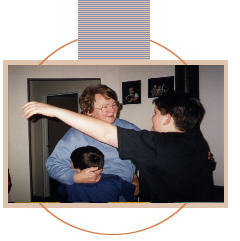



|
|
Overview |
|

![]()
The Journey and sin:
Ongoing Conversion
"The quality of mercy is not strained."
Shakespeare.
Confession, Penance, Reconciliation have fallen into a bit of a ‘black hole’ in Catholic practice today. We have just come out of "the golden age" of frequent confession of the 1930-1960s and the pendulum seems to have swung the other way. Catholics seem to have shifted from an attitude that saw Confession to a priest as the only way of being forgiven to a wider understanding of Reconciliation. This in itself is a good thing yet it raises the raw question, ‘Who needs to go to a priest for forgiveness; why go to Confession at all?’
In the year 57, St. Paul wrote to the Christians at Corinth:
...if anyone is in Christ, there is a new creation: everything old has passed away: see, everything has become new! All this is from God, who reconciled us to himself through Christ, and has given us the ministry of reconciliation; that is, in Christ God was reconciling the world to himself, not counting their trespasses against them, and entrusting the message of reconciliation to us. So we are ambassadors for Christ, since God is making his appeal through us; we entreat you on behalf of Christ, BE RECONCILED TO GOD. See, now is the favourable time; see, now is the day of salvation! ( 2 Corinthians 5:17-20, 6:2b)
To reconcile is to re-unite, to bring back to harmony, to heal division, separation, rupture. The Christian perspective seeks reconciliation with God, with one another, between nations and with our environment.
The life of Jesus was totally dedicated to RECONCILIATION; the life of Christ's faithful, the Church, is to be a symbol of this reconciliation. We are Sacraments of unity, ‘Ambassadors for Christ.’
All the sacraments have this reconciliation element.
· BAPTISM initiates a person into the quest for reconciliation. We are immersed in the waters, drowned to disunity and discord, alive to harmony and oneness. We are reconciled to the ‘Original’ state.
· CONFIRMATION empowers us to live by and to know the strength of the Spirit of God within and opens us to know that God is really alive in us. In the Spirit we hear the Father's words ‘you are mine, the beloved, my favour rests on you’. We are gifted ‘children of light’ who turn AWAY from darkness and serve God's saving plan with our gifts.
· EUCHARIST is the nourishment of our lives ‘so that sins may be forgiven’. It is not a reward for being good. It nourishes our quest, our journey, to be perfect, ‘compassionate as my heavenly Father is compassionate’.
· MARRIAGE celebrates two people constantly touching one another with the healing love of God in their lives. They seek to resolve any brokenness in relationship, so creating a life of harmony and love.
· ANOINTING OF THE SICK is about a person coming to reconciling hope in their illness so that the destructive power of their illness gives way to new hope and new possibilities even if illness and limitations remains, even if death occurs as a final reconciling healing.
· MINISTRY and ORDER seeks to be a focus of the community's quest for harmony, to be a centre for conflict resolution, to be a symbol of ‘Holy Order’ in our world.
· RECONCILIATION, as one of the seven sacraments, is a new moment of grace and a time of awareness about our personal and social sin, calling us to remember our Baptismal commitment, our life confirmed in the Spirit, our unity with the Eucharistic people.
And, as well as all sacraments incorporating reconciliation, the Christian tradition and teaching celebrates reconciliation in many ways, apology, prayer, penance. In all this the question about the relevance and necessity of the Sacrament of Reconciliation still remains for many. People are asking this question especially about children and Reconciliation.
The core of its relevance and celebration of the Sacrament of Reconciliation comes from listening to the Parable of the Lost Son in Luke 15. This is Jesus' story of mercy. As we reflect on Luke 15 we see that the Sacrament of Reconciliation ritualises this story. The Sacrament associates us with the story:
· We stand before God as the Son stood before his Father. We do this as ‘two gathered in my name’ - the penitent and priest. The priest is shepherd, director of our spiritual journey.
· We speak what we have come to know about ourselves, as the son admitted that he had ‘mucked-up’ (the pig sty image) his life. We speak out; we "exorcise" our sin in the language of our confession.
· We accuse ourselves as the son did – ‘I have sinned against heaven and against you’. Neither God nor the priest judge us, we judge ourselves
· We pass sentence on ourselves as the son did – ‘I am no longer worthy to be called your son’. Neither God nor the priest sentences us.
· We ask humbly to be taken back into the ‘Father's House’ as the son did. We have ‘come to our senses’ and see the sense of God's way of life shown to us in the Gospel of Jesus.
· We experience the compassion of a God who touches us with power and embraces us with energy and loving kindness as the son was embraced and rejoiced over by his understanding Father. The laying on of hands and the prayer of absolution, and the encouragement and direction that the priest offers us are images of this.
· We are challenged to enter more fully into the loving mercy of the Father as the second son was.
By giving us this parable Jesus reveals a new perspective on sin and evil - MERCY rather than JUDGEMENT, UNDERSTANDING rather than CONDEMNATION.
This story has to do with God as Trinity. The Son is one with the Father in the Spirit of Mercy and Love. Jesus calls us to understand the Father/Son relationship in the power of the Spirit. Live always and forever in that ‘House’ is the invitation of this classic story of Jesus.
To sin is to distance oneself from that relationship as the Prodigal son did, or, like the second son, to refuse the call to enter into the Father’s compassion and mercy. All evil is the consequence of the human person trying to come to terms with existence on a basis other than this Parent/Child relationship. The language of confession and the Sacrament of Reconciliation are symbols of the constant response to the call to live in that relationship. In this is the key to discovering how often one ought to seek the sacrament.
As always with sacraments, to see Reconciliation in all its power is to live in the realm of the symbolic and the spirit. Its simple structure gives us a chance to be aware of who we are, standing before God and ourselves and the community's life. We own who we are and seek the spirit of God to be with us, to renew us, to redirect us.
Also, to see the relevance of this Sacrament is to answer questions about its role in our lives. The emphasis has been misunderstood in the past. ‘I don't have to go to a priest to be forgiven!’ is hardly the issue. The issue is that this sacrament allows a person, within a communal setting, a CONSTANT EXPERIENCE of on-going awareness of Conversion, a turning of life, a changing of mind and heart.
The structure of the Rite of Reconciliation, within a wider understanding of the reconciling mission of the Church, seeks to allow us to do all this. There are three forms of the Sacrament that express both the individual and social aspects of our conversion. The Second form that gathers us together in prayer and then allows for each person to individually approach a priest seems to best express the communal and personal nature of Reconciliation.
This communal aspect of sacramental life is especially challenging in these times as we are challenged to social as well as personal responses to the Gospel. The church is seeking to clarify its own identity in this time of history and in many cultural situations. It is clarifying its mission as it constantly converts itself and challenges each cultural system and its values to bring about the ‘new creation’ that is ‘all God's work’.
In all these forms of the sacrament of Reconciliation
- we stand before God in hope as the priest welcomes us and encourages us;
- We examine our consciousness about our experience of God breaking in to our lives;
- We seek to accept the values of the Kingdom;
- We ask God to enter into those areas of our lives where Jesus is still not Lord;
- We ask to be welcomed again into the ‘Father's House’;
- We pray in sorrow and for the Spirit to be on us in a fresh way so that we are a symbol of God's compassion and mercy (cf. the second son in the Prodigal Son parable).
Schema
There are three Rites of Reconciliation
1. Rite for the Reconciliation of Individual Penitents.
2. Rite for Reconciliation of Several Penitents with Individual Confession and Absolution.
3. Rite for Reconciliation with General Confession and Absolution.
This overview of the Sacrament according to the 1973 revision gives us the personal and social dimensions of Conversions and Reconciliation.
Perhaps the best expression of these two dimensions is found in the Second form – a gathering of the Community where there is Individual Confession and Absolution.
We are still very much in the process of rediscovering the power and beauty of this sacrament.
Further Reading
Dallen, James. "The Reconciling Community: The Rite of Penance."
Pueblo, New York. 1986.
The history and theology of the Sacrament of Reconciliation.
|
|
|
|


Copyright © Anthony Kain 2009